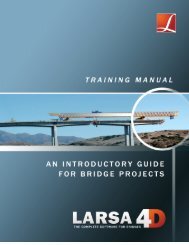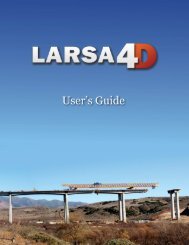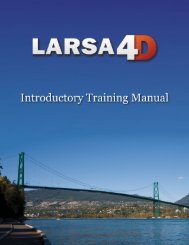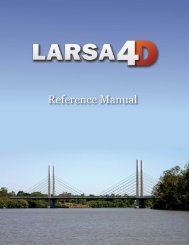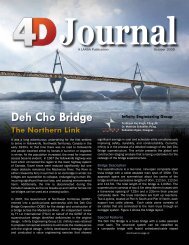You also want an ePaper? Increase the reach of your titles
YUMPU automatically turns print PDFs into web optimized ePapers that Google loves.
Live Load Analysis<br />
with Influence Surfaces<br />
by Joshua Tauberer<br />
Director of Software Architecture<br />
Live load codes impose some<br />
of the most computationally<br />
intensive requirements on<br />
structural analysis. On a bridge<br />
deck of a certain size, what<br />
are the locations of the traffic<br />
lanes and the vehicles on the<br />
lanes that produce the greatest<br />
moment somewhere on the<br />
structure? Design codes add<br />
on top of the variability in traffic<br />
lane and vehicle locations the<br />
additional variability of vehicle<br />
type and length. One traffic lane<br />
may be loaded with a special<br />
permit truck and the remainder<br />
with AASHTO LRFD HL-93s, each<br />
with variable rear axle spacing.<br />
Compared to the static analysis which in finite element<br />
analysis has the closed-form solution D=K -1 P (the inverse of<br />
the stiffness matrix multiplied by the load vector), live load<br />
analysis is a much more intensive combinatorial problem.<br />
LARSA 4D includes influence analysis using both influence lines<br />
and influence surfaces. Influence lines are used in models in<br />
which the deck surface is modeled as a part of the girder lineelement<br />
cross-sections. Each influence line represents a single<br />
traffic lane at a user-identified transverse location. The lines<br />
may be put together into factored combinations using LARSA<br />
4D’s linear result combinations and extreme effect groups<br />
tools. Options include vehicle type (standard or user-defined),<br />
variable axle spacing, variable vehicle spacing for multiple<br />
vehicles, patch loading for UDL, and (in LARSA 4D version 7.5)<br />
factors for centrifugal force effects for curved bridges. Also<br />
supported is the span-by-span loading requirement of AASHTO<br />
LFD. (A tutorial for influence lines can be found in the LARSA<br />
4D Introductory Training Manual for Bridge Projects.)<br />
Influence surfaces are a much more powerful and robust<br />
method for live load analysis. With an influence surface<br />
computed for the entire deck surface area, LARSA 4D can<br />
automatically find the transverse locations of as many traffic<br />
lanes as will fit on the surface. This saves the user the time<br />
of choosing lane locations, modeling separate influence<br />
lines, and forming factored combinations. With an influence<br />
surface the separate lane effects are combined using supplied<br />
multiple presence factors automatically. Additional options<br />
for influence surfaces include traffic lane width, vehicle<br />
margins, and UDL width within each traffic lane, and having<br />
up to one lane with a different vehicle from the rest for local<br />
permit loading. Influence lines and surfaces can be used with<br />
curved and skewed bridges. (A tutorial for influence surfaces<br />
Influence Surface Results Case Window<br />
•LARSA’s 4D <strong>Journal</strong> • May 2010•Page 8<br />
can be found in the LARSA 4D<br />
Advanced Training Manual for<br />
Bridge Projects.)<br />
LARSA 4D has introduced new<br />
tools for live load analysis in each<br />
major update. Starting in version<br />
7.5 of LARSA 4D, influence<br />
analysis has been upgraded to<br />
be significantly faster especially<br />
for wide decks that fit three or<br />
more traffic lanes. The analysis<br />
also makes use of multi-core/<br />
multi-CPU computers, spreading<br />
the combinatorial investigation<br />
across all available processors.<br />
We have found a 2x speed<br />
improvement on four processor<br />
cores and a 4x speed improvement on eight processor cores,<br />
on top of the speed improvements compared to influence<br />
surface analysis in version 7.01 found even on single-core<br />
computers. The new version also adds support for the spanby-span<br />
requirement of AASHTO LFD to influence surfaces with<br />
automatic lane positioning.<br />
As with all development at LARSA, new capabilities are always<br />
driven by feedback from our clients. We look forward to hearing<br />
how we can continue to evolve LARSA 4D’s live load analysis to<br />
meet all of our clients’ project requirements.<br />
What’s New To Influence Surface Analysis in LARSA 4D Version<br />
7.5<br />
• Centrifugal force factors can be specified which automatically<br />
adjusts vehicle wheel magnitudes. Multiple factors can be<br />
specified to apply difference factors on different segments of<br />
a single influence surface.<br />
• Some codes require at most one lane of one vehicle type, with<br />
the remaining lanes loaded with HL-93. This is now supported.<br />
• AASHTO LFD point loading is now supported for influence<br />
surfaces with multiple design lanes.<br />
• Influence analysis is now multi-threaded on computers with<br />
multiple processors or multiple cores.<br />
• Influence surface coefficient grid spacing can be larger without<br />
as much loss of accuracy because of better load positioning.<br />
• Results are faster and more accurate when more than two<br />
vehicles are placed on the surface because of an improved<br />
vehicle position search procedure.<br />
• Influence surface design lanes are now able to include UDL<br />
without vehicle loading to allow more flexibility in creating load<br />
combinations.•



